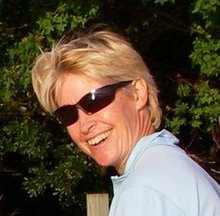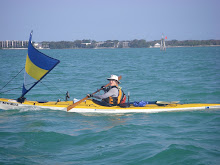DAY ONE: Normally, the IntraCoastal Waterway (ICW) running from Tampa south is pretty busy over the weekend, with pleasure boats of all sizes kicking up a sloshing wake, particularly in the narrower channels. I wondered why it was so quiet, until someone at Checkpoint 1 mentioned that there was a Small Craft Advisory out. And that was the reason for the pretty quick 100km (60 mile) run from the 0700 start at Fort De Soto beach, down to Cape Haze Marina, the new CP1.
Using the
FEK sail I had a nice run across the very open eight miles of Tampa Bay, the forecast northerlies pushing us along. Half way across it steadily grew darker as a wide band of showers ran over, but quickly clearing. The winds calmed a little in the lee of the first bridge, and as we entered the big open expanse of Sarasota Bay, I was wondering if the stronger northerlies had faded out. I didn't have to wait long. About half-way across the bay, they kicked in, and it was all downhill from there. Running down Sarasota I hit my second top speed of the EC, at 8.9 knots, and was consistently running from 5.5 to 6.5 knots, averaging 4.5 knots over the entire day—in fact 4.5 knots for the next three days. Occasionally, the bow of the kayak would submarine, but the surfing was superb. (I so wished I had a GoPro camera to film it all!) A number of times the rudder couldn't cope, and I'd use my Greenland paddle to help steer.
I had one four minute pit stop along the way, drank three litres of 50% diluted Gatorade, and ate about six bars—it was the only day I was really hungry.
11 hours and 50 minutes later—after 100km (60 miles)—and still in daylight, I landed at the new CP1, at Cape Haze Marina (blue roofs, bottom right of the image). I made sure to stick to the channels coming in, as the oyster bars protecting the entrance are pretty bad. A few folks had taken a short cut, and a couple had run aground.
I was a bit surprised to see a few Class 1 and 2 folks out of the water, setting up tents, and not heading on down the coast. After a royal greeting by Floatsome (CP1 manager), who very kindly brought me a cup of hot soup (yum!), and directed me to the water filling station, in about 30 minutes, I was up and off, gently lowering myself back into my boat—the new checkpoint doesn't have a ramp. It was just dark as I left, and Jarhead in his Sea Pearl paddle sailed out with me—with another Sea Pearl—I passed them as we set off south.
My plan for the night was to paddle the nine or so miles south, to sleep the night at Dog Island, my usual stop just outside the old CP1. I had a terrific calm paddle sail, making the island in about 90 minutes. A large party was camped where we normally pitch our tents, with a huge wind block awning up and behind that a roaring fire. I paddled around to the east, and found a beach and small path up to a raised area. Tent was up in no time. An hour or so later, SandyBottom arrived, just as it started to rain. and it rained all night. It was the best night's sleep I was to have this EC.
Top middle photo by SpeckTater.
Upper top and bottom top photos by Glen Hayes.
DAY TWO: Around 0400, the wind blew! It sounded like a mini hurricane, particularly with trees around us thrashing. I whispered out to Dawn, "Can you hear that?!" She could. We packed up in the dark, and by the time we were ready to leave, dawn had broken and the wind had calmed considerably.
Paddle sailing south, we took a route for Bull Bay, but in trying to make a bit of east for Charlotte Harbour, I had us meandering too far east, finally doubling up and over to the eastern side of Bull Bay. Though we did find some possible camping spots...

We'd decided to stick together this morning, to check out the conditions for Charlotte Harbour—there are times the open crossing can be a bit hairy. About a quarter of the way across we agreed it was nothing, and Dawn gave me permission to scoot on. I had a great run across, and with the wind easing, meandered down Pine Island Sound's Matlacha Pass. I was a mile or so south of the bridge, with a northly breeze pushing me on, when the bolt dropped out of my FEK sail, where the boom fits the mast. It fell about a foot and landed right at the base of the mast. I couldn't reach it, and there was no where to land near me to rescue it. I slowly lowered the sail, and sat there, not taking my eye off the bolt. Looking back, I could just see a Kruger in the distance, and thought it must be SandyBottom. After about five minutes I recognized it as CWolfe/Charles. And for another 20 minutes, I just sat there, too scared to move and roll the bolt overboard! As CWolfe drew up beside me, I explained my situation; he very kindly found his Leatherman (now on my to-buy-list!) and screwed the bolt back in, recommending I purchase a tube of Threadblocker. We paddled on a bit together, but I drew ahead pretty quickly.

I'd been considering whether I'd be running the inside or outside route to Wiggins Pass, which I was fairly sure would be my port of call for the evening. Once outside of Sanibel Bridge, I decided that the inside route—one I haven't made all the way yet—would be the safest—there was a pretty stiff northerly, with seas around a metre or so. A Hobie T1 shot out from under the bridge with me, and soon I could tell it was Chief, reefed down for the crossing to Matanzas Pass. What a ride over to Matanzas—I hit 9.8 knots sail surfing the couple of kilometres across!
It was a very pleasant paddle sail along the back way, passing Big Carol Pass, New Pass, and then on to new paddling territory. The chart has the channel markers stopping at New Pass, meandering on south, but they actually do exist.
And with the tide (going out), about half an hour before dark, I made Wiggins, seeing it from the rear for the first time.
Tent up, can of sardines down, dark fell, and a few more boats started slowly arriving. I hit the sack, and SandyBottom arrived a few hours later.
DAY THREE: Up in the dark, Dawn and I headed off just as dawn broke. We decided to head out Wiggins Pass together, in the interests of safety, with the seas being against the tide. Heading out wasn't too bad, with some breaking waves around two metres. (We later learned that a couple of kayaks behind us had capsized.) I pulled away, and wouldn't see SandyBottom until the next day.
Jungle Jim was paddling his Epic 18Sport ahead of me, and a wee while later, CWolfe passed by in his Kruger, with full Balogh flying and a two-metre PAS. With a pretty consistent 4.5 knots paddle sailing, I later passed JungleJim and then CWolfe. With superb surfing skills, JungleJim was soon to retake the lead.

With the two to three metre swells rolling in along the coast, I stayed about about a kilometre or so offshore. It was quite something, and I kept an ever vigilant eye to sea. Which is probably why I missed Gordon's Pass, and then Big Marco Pass (how does one miss Big Marco Pass?!) and then nearly missed Caxambas Pass! With the conditions they way they were, Caxambas was Plan A, with Big Marco Plan B. I'd run it once before, years back with NatureCalls, and had it plotted into my GPS. And the moral of this story is, to always trust your GPS. As I've written, I nearly missed Caxambas Pass—in fact I was a kilometre past it, on my way to Cape Romano, when I figured out where I possibly was. My GPS said I was at Caxambas, but utterly amazed that I'd missed the huge opening of Big Marco, for some crazy reason, I wasn't sure. All the huge hotels were there, right on the northerly edge, and there were only uninhabited keys to the south—it sure looked like Caxambas... I called FliesWithKiwiBird on my cell phone: "Everything's okay (always good to start with that). Can you tell me where I am?" Having downloaded the app to her phone, the response was, "It looks as though you've passed something called Big Marco Island." I called Floatsome—he figured I was there, too. So back north I paddled, through some pretty exciting surf, and in Caxambas I went. Meandering through the keys, a little while later I passed CWolfe, who wondered how I'd got behind him, and then up behind me came JungleJim, who'd taken a wrong turn after making Caxambas.
I later realized that the reason I'd missed seeing Gordon's and Big Marco was because I was off the coast a way, and had been looking out to sea more, watching the sometimes breaking swells.
From Neal Key to the entrance to Chokoloskee, it's a run of about 12nm. I had a great paddle sail across, and could see PenguinMan inside a bit further, steadily making ground. And JungleJim was off.
Finding the tide coming into Chokoloskee, I just kept on paddling up to the Rangers Station, outside of Everglades City. Just before entering Chokoloskee Bay, a skiff with two Rangers powered past me, on their evening patrol. By the time I reached the Rangers Station, about 30 minutes before dark, they'd returned to the dock. I paddled up to them, took off my hat and signaled I wanted to chat. They spoke first: "Are you with WaterTribe?" "Is it my hair?" I responded. I explained that I was a night ahead of schedule, and not having anywhere to camp, would they mind if I left my boat at the ramp and pitched my tent behind the shed there. "It's against Park regs, you know. But okay." I thanked them profusely and paddled around the corner.
I called WhiteCaps/Toby, manager for CP2, and let him know where I was, and that I couldn't be bothered paddling all the way to CP2, to have to paddle back in the morning for the permits we'd need for the Wilderness Waterway, and then back again. He understood,even though it would mess up my CP arrival times (as soon as I hit CP2, I'm on holiday!), and was around with JungleJim in about half-an-hour to chat. Always good to see Toby.
I pitched my tent, cleaned up, and staggered drunkingly across the road to the fish restaurant, where I delighted in grilled scallops, shrimp and grouper, washed down with a Heineken.
Terrible night's sleep, and I don't think I'll camp there again! Around 0200, and for the next two hours, all the big dieseled fishing boats left Everglades City, less than a kilometre away. It was deafening!






















































